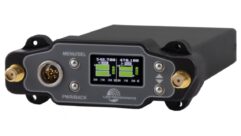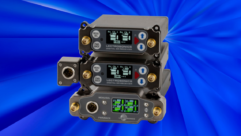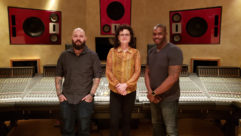
AES 2007
Nov 1, 2007 12:00 PM,
By George Petersen
Audio hits for live-sound pros.
Web-expanded Version

JBL VRX932LAP
While the rest of the world may spend the start of fall enjoying brilliant autumn colors and making holiday preparations, audio industry professionals (some 20,674 this year, to be exact) kick the season off with their annual pilgrimage to the Audio Engineering Society (AES) convention, where they feast on a host of new and improved technologies. Held this year in early October at New York’s cavernous Jacob K. Javits Convention Center, AES featured 445 exhibitors showing off their wares. With much of its emphasis on recording gear, AES is hardly a show focused primarily on installation professionals, and yet, in the live-sound category, there were plenty of new and interesting debuts of products in the install/portable PA market — even if ceiling speakers were almost nowhere to be found.
With that in mind, I checked out live-sound technologies at AES, and I was not disappointed. Following are a few important developments that caught my attention.
LOUDSPEAKERS
AES proved a fertile environment for launching new loudspeaker systems for serious PA applications.
For small-to-medium permanent installs or large-format touring, the Metrix Multipurpose Line Source series from Adamson offers front-fill, lip-fill, or out-fillarrays. The enclosures feature both5-degree (Metrix) and 15-degree (Metrix Wave) vertical patterns, with 120-degree horizontal dispersion. The two-way box has an ND8-ML 8.5in. Kevlar neodymium mid-low driver and a 1.4in. HF compression driver on Adamson’s patented HF wave-shaping chamber. A flyable, dual-15 cardioid sub is optional.
Now in a self-powered version, the PD10E-I, double-10 sub from Bag End is specifically designed to fit into locations where space is at a premium. The impossibly small — 13″×22″×13″ (H×W×D) — system packs a lot of bass — down to 8Hz — into a compact, 49lb. cabinet, thanks to Bag End’s exclusive INFRA technology. The built-in Minima One 1000W high-efficiency amp weighs just 5lbs.
Using the DrivePack DPC-2 amplification system, the JBL VRX932LAP two-way, 12in. line array and the VRX918SP 18in. subwoofer are fully self-contained powered loudspeakers. The two models retain all the features of the original VRX932LA and VRX918S with self-powered performance optimized through integrated DSP. Designed for use in arrays of up to five units, the VRX932LAP is suitable when line-array performance is needed but the venue size does not require large, long-throw line arrays. The VRX932LAPs can be used on a tripod or pole-mounted over a sub, and they are flyable.
L-Acoustics was showing its successor to the SB218 subwoofer, the SB28, which delivers greater LF impact and bass articulation. Powered by the new LA8 amplified controller, the system has two front-loaded, 18in. woofers in a bass-reflex-tuned enclosure capable of operating down to 25Hz.
Meyer Sound proved that size isn’t everything with its self-powered MM-4XP miniature loudspeaker. Only 4in. square, this self-powered version of Meyer’s popular MM-4 has onboard amplification and corrective processing, and it receives 48VDC from an external power supply on a 5-pin EN3 connector that also carries balanced audio. The unit is designed for instances where space is limited or visibility is a factor, such as fill and spot coverage, or installation in steps and other hidden locations, as well as touring sound applications such as stage lip front-fill and small portable PA systems. Its 4in. driver is capable of a 113dB max peak SPL with a 120Hz-to-18kHz response.
The first line-array system to come with the fully integrated RHAON (Renkus-Heinz Audio Operations Network) package, the Versys VL3 from Renkus-Heinz has a truck-pack-friendly design. It includes a new RHAON in-cabinet PM3R Class-D tri-amplifier, full digital dynamics with networked audio over CobraNet, and loudspeaker monitoring and remote control, all delivered over a single Cat-5 cable to each loudspeaker. The three-way VL3 system incorporates dual 12in. neodymium woofers and dual custom-designed CDT-1.5V CoEntrant MF/HF devices with 6.5in. cone mid drivers and 1.5in.-exit/3in.-diaphragm HF units. The CoEntrant MF/HF device is mounted on a compound phase plug attached to an isophasic plane wave generator offering 60-, 90-, and 120-degree horizontal dispersion.
Now available through Allen & Heath distributor American Music & Sound, Turbosound was showing its TA-500t and TA-500tDP enclosures at the show. The TA-500t is a trapezoidal, bi-amp/tri-amp three-way enclosure with a 1in. HF driver on a Polyhorn device, a 10in. MF on a Polyhorn, and a Turbo-loaded 15in. LF for a 60Hz-to-20kHz response from a 125lb. cabinet. Its 50°×25° (HxV) dispersion focuses with minimum overspill. The powered, networkable TA-500tDPs offer realtime control and monitoring of operating parameters with a PC running TurboDrive software over a BVNet network or remotely.
MICROPHONES
AES has always been a place to find new and interesting microphones. Audix has expanded its ultra-compact Microscondenser-mic series, which now includes more than 20 models. The new 2in.-body M1250 and 3.5in.-body M1280 have a 40Hz-to-20kHz response, and they feature greater immunity to RF interference caused by cell phones and GSM devices. Each model has four interchangeable capsules to choose from: cardioid, hypercardioid, omni, and shotgun/supercardioid. Accessories include Micropods (integrated 6in., 12in., and 18in. goosenecks), Microbooms (50in., 2.5oz. carbon fiber boom), and various instrument mount clips.
Heil Sound offered a fun new model. The Fin puts a modern, dynamic element into a stylish, Art Deco-style housing offering a 60Hz-to-18kHz response. Designed for stand mounting, the Fin also features internal shock mounting for its cardioid capsule and four (switchable) blue LEDs inside the mic that glow when the mic is connected to a phantom power source.
Sennheiser showed a line of condenser mics based on its flagship MKH 80, but the mics are less than half the price. Available in cardioid, omni, and super-cardioid versions ($1,299 each), the new MKH 8000 series features a mic head and a separate XLR module, with bandwidth from 10Hz to 60kHz, depending on the capsule. In tight spaces, the mic head can be attached to a remote-capsule option to create a compact mic assembly.
Also new is Sennheiser’s E 912 E boundary mic, with a half-cardioid pattern optimized for speech. An internal DIP switch can tailor the mic’s response curve to match the response of the E 912, or select low cut, low/high boost, or low boost. The mic can be switched on/off using the integrated programmable membrane switch. A second internal DIP switch provides additional selections, including on/off, a push-to-talk button, a cough button, or permanently on.
AES 2007
Nov 1, 2007 12:00 PM,
By George Petersen
Audio hits for live-sound pros.

This year’s AES convention emphasized not only recording gear, but also products in the install/portable PA market.
OUTBOARD
With the ongoing trend toward virtual and plug-in signal processing software, it was nice to see some real, serious outboard devices.
Lexicon introduced its PCM96 professional stereo reverb/effects processor, a 1RU unit that can operate via its 2-channel analog or AES/EBU digital I/Os or act as a control-only DAW/digital console insert or FireWire streaming hardware plug-in. The PCM96 has a comprehensive selection of legendary Lexicon reverbs and effects, and it can store/transfer presets via MIDI or a front-panel CompactFlash slot.
Real Sound really turned some heads with its Coneq APEQ-2PRO acoustic power equalizer. The 1RU unit provides two channels of high-resolution EQ correction based on acoustic power frequency response. Unlike conventional SPL frequency-response techniques, Coneq enables inverse FIR-filter corrections to be applied with repeatable success. Following the measurement process (about 2 minutes), Coneq synthesizes a 4,096-point inverse filter that precisely corrects a loudspeaker’s frequency response to a flat target response or to a specific “personality profile,” which can be anything the user requires.
AMPLIFIERS
This year, AES proved that amplifiers can be anything but boring.
The PLM 10000Q from Lab.gruppen incorporates Dolby’s Lake processing crossover, delay, EQ, and limiting with 10kW of amplification in a single chassis with remote monitoring and front-panel or software-based control.
L-Acoustics showed its LA4 and LA8 amps, which combine 4×1000W or 4×2000W amps with DSP, network control, monitoring, and an onboardL-Acoustics preset library.
Nexo debuted its NXAmp line with two new 4-channel, Yamaha-powered amps that can also be configured in 2×2 bridge mode, providing up to 4×4000W or 2×8000W, along with control navigation across all Nexo ranges, system setup, protection, delay, output gain, and array EQ.
Yamaha previewed its three new amps: TX4n (2200W), TX5n (2500W), and TX6n (3000W) — all with onboard DSP and a sophisticated 24-bit, 96kHz DSP engine enabling a wide range of control/processing capabilities.
INTO THE MIX
Allen & Heath (A&H) is now shipping its iLive-80, the smallest of the four control surfaces for its iLive digital mixing console system. Designed for smaller applications, such as live theater, houses of worship, and touring bands, the unit has 20 faders, each with four banks for accessing up to 80 channels, with a multicolor backlit LCD display above each fader for labeling and color-coding channel data. A color LCD touchscreen offers access to dynamics, EQs, effects, automation, and setup screens.
A&H was also showing ZED, its new series of small format analog mixers (with USB I/Os) for live performance or recording. The ZED-14 has six mono channels (with 3-band, swept mid EQ) and four stereo channels (with 2-band EQ), and provides 13 independent sources to the mix; 10 independent outs; two pre-fade/two post-fade aux sends; and USB send/return for PC/Mac recording, playback, and effects.
Also on the compact side, ProRack mixers from APB-Dynasonics are compact 10RU designs that, like the company’s Spectra Series, feature minimum phase-shift circuitry, expressive EQ, and high-performance preamps. The ProRack-House has 12 mono input channels and four dual-mono/stereo input channels (20 mic preamps in total). The ProRack-Monitor is fitted with 16 mono input channels, and it can create eight stereo mixes and two mono mixes, while adding a passive input-splitter system.
Digidesign unveiled new software for its popular D-Show and D-Show Profile consoles. The new D-Show 2.6 software adds support for Aviom Pro16 Series personal monitoring/mixing devices via Digi’s new ANO A-Net output card, with auto/manual stereo linking of adjacent channel pairs, easy setup and testing of all Aviom Personal Mixers, faster plug-in load times, improved workflows, and expanded signal routing possibilities.
Mackie announced the Q4 2007 availability of its TT System32 digital live-mixing system, priced at $12,999, which consists of the TT24 digital live console, DS3232 digital snake, and the U100 networking card, offering a complete, plug-and-play digital live-mixing solution—just add stacks and racks. TT System32 provides stage-to-console connectivity via the DS3232 digital snake with 32×32 analog I/O, 32 mic preamps, and complete remote recall/control of all preamp settings (gain, pad, and phantom power) all through a single, lightweight Cat-5 cable.
The RSS M-400 digital mixing and recording system from Roland Systems Group brings ease, convenience, and quality to installations and live-sound events. The V-Mixing System comprises a Cat-5e digital snake up to 48 inputs, a 48-channel digital mixing console, and splits for recording. The M-400 V-Mixing console features rapid recall of scenes; 100mm motorized and touch sensitive faders; a large bright 800×480 color screen; dedicated effects knobs for EQ, pan, and gain; digital effects; and remote controllability.
Soundcraft released a significant update to the operating software for its Soundcraft Vi6 and Vi4 digital live sound consoles, adding powerful new facilities and further security in the event of power failure. New features include channel copy/paste capability; a library function for storing, archiving, and recalling parameters (internally or to a Memory Stick); and a new auto-backup system that retains and restores the desk’s last settings automatically when power is restored—meaning no changes to the audio.
When not writing for Mix or Sound & Video Contractor magazines, Senior Consulting EditorGeorge Petersenoperates a small record label atwww.jenpet.com.
For More Information
Adamson
www.adamsonproaudio.com
Allen & Heath
www.allen-heath.com
APB-Dynasonics
www.apbdynasonics.com
Audix
www.audixusa.com
Bag End
www.bagend.com
Digidesign
www.digidesign.com
Heil Sound
www.heilsound.com
Lab.gruppen
www.labgruppen.com
L-Acoustics
www.l-acoustics.com
Lexicon
www.lexiconpro.com
Mackie
www.mackie.com
Meyer Sound
www.meyersound.com
Nexo
www.nexo-sa.com
Real Sound
www.realsoundlab.com
Renkus-Heinz
www.renkus-heinz.com
Roland Systems Group
www.rssamerica.com
Sennheiser
www.sennheiserusa.com
Soundcraft
www.soundcraft.com
Studer
www.studer.ch
Turbosound
www.turbosound.com
Yamaha
www.yamahaproaudio.com









